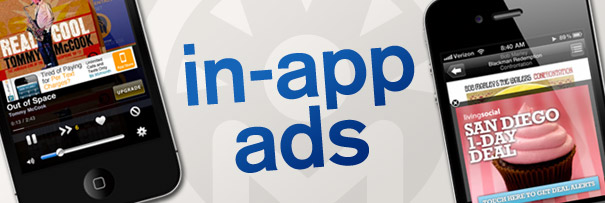
Mobile advertising is becoming an integral part of advertising strategies due to the fact that it can conveniently reach consumers right in the palm of their hands. This year, it seems the best way to reach users are through apps as they are being downloaded everyday for almost any occasion, opening the door to integrate mobile advertising more fluidly in a campaign while search, shop and share tools, such as QR codes, continue to play a major role.
With 95% of mobile users downloading and using free apps, worldwide mobile app revenue will triple to $15.1 billion and downloads will more than double to 17.7 billion this year alone. While it is estimated that 51% of the US will have smart phones by the end of 2011, the popularity of tablets are growing as well with speculation that 50 million Americans will own a tablet computer in the next year. To keep the increasing number of tablet and smart phone users engaged through apps, iAds – a new form of mobile advertising that explores the capabilities of smart phones and tablets through rich media – is needed. Even more so when considering that mobile app revenue, especially for free apps, is made by cost-per-click mobile ads. While CPC mobile ads are a great way to advertise, CPC ad dollars are often wasted because users frequently click or tap the ads by mistake. In fact, a survey conducted by Pontiflex and Harris Interactive found that 47% of mobile app users click ads unintentionally with 61% being 18-34 year olds – the most active group of mobile users. However, the survey also found the solution that 71% of app users prefer in-app ads that don’t take them out of the app.
The Tron movie and Campbell’s Soup in-app ads are great examples that showcase the ease of use and creative possibilities of mobile advertising. The Tron movie in-app ad was one of the first highly interactive and graphical iAd campaigns featured on the iPad, utilizing videos, a photo gallery, theater locater with showtimes, preview and purchase of the movie soundtrack, and sharing through email and social media. Similarly, the Campbell’s iAd featured reformatted condensed soups, recipes, coupons and links to download all within an interactive and convenient interface. A survey focused on the success of iAds even stated, “consumers shown an iAd remembered the brand five times more often than TV ad respondents and the ad messaging three times more often.”
Based on our research of in-app mobile advertising, there are endless possibilities in combining full interaction and emotion with user-friendly aesthetics. Mobile advertising is different from online advertising; with innovative technology and interface capabilities such as swiping, sensors and GPS, it makes sense to create an app within an app for a more uninterrupted, engaged experience.
To heighten the engagement, having the in-app ad relevant to the actual app and following through on what is advertised is imperative. For example, since mobile gaming is the most popular app category, even mimicking a highly interactive game can engage and connect with users more.
Two additional features that should be utilized are location based ads combined with special offers. 57% of users are more likely to engage with an ad that is relevant to their location while 17% of consumers make purchases because of those ads. Ads containing local coupons, deals or newsletters are more likely to be clicked on as well. Lastly, don’t forget to also incorporate social media to top off the experience and allow others to be engaged.
As iAds and in-app ads are reinventing mobile advertising with fully interactive experiences and emotional impact, there’s more to be said about mobile websites and mobile search. Stay tuned for Mobile Advertising Part 2 in next month’s blog.
*BONUS* Check out this video that showcases the “flashy” interactive things that can be done with in-app ads: